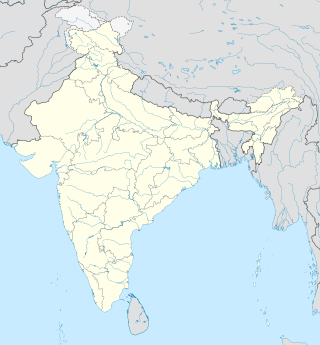Rajasthan nuclear power plant
| Rajasthan nuclear power plant | ||
|---|---|---|
| location | ||
|
|
||
| Coordinates | 24 ° 52 '20 " N , 75 ° 36' 50" E | |
| Country: |
|
|
| Data | ||
| Owner: | Nuclear Power Corporation of India LTD. | |
| Operator: | Nuclear Power Corporation of India LTD. | |
| Project start: | 1963 | |
| Commercial operation: | Dec 16, 1973 | |
|
Active reactors (gross): |
5 (1080 MW) | |
|
Reactors under construction (gross): |
2 (1400 MW) | |
| Energy fed in in 2007: | 2,495 GWh | |
| Energy fed in since commissioning: | 53,117 GWh | |
| Website: | Side of the operator | |
| Was standing: | December 31, 2009 | |
| The data source of the respective entries can be found in the documentation . | ||
The Indian nuclear power plant Rajasthan , also called Rajasthan Atomic Power Station (RAPS) or Rawatbhata Atomic Power Project (RAPP), is located about 65 kilometers from Kota on the Chambal , about three kilometers above the dam that dams the Rana Pratap Sagar reservoir. The plant is located in the state of Rajasthan , Chittorgarh district .
The next town is Tamlao. Rawatbhata is about eleven kilometers away. The workers of the power plant are housed there. A heavy water factory has been located in Kota since the 1980s .
RAPS-1 is India's first pressurized water reactor with heavy water moderator (PHWR). Construction began in 1971 with Canadian help as a 220 MW reactor; the reactor went critical on August 11, 1972 . After the Indian nuclear weapons test on May 18, 1974 in Pokharan , Canada withdrew from the cooperation. Therefore, the second reactor did not become critical until October 1980.
After many incidents and repairs, the RAPS-1 now has an output of 100 MW, the RAPS-2 approx. 200 MW.
As part of the Indian nuclear program , three more PHWRs with an output of 220 MW each were built. RAPS-3 became critical on December 24, 1999, RAPS-4 on November 3, 2000, and RAPS-5 on December 22, 2009. The RAPS-6 block finally went online for the first time on March 28, 2010.
Two further reactors (RAPS-7 and RAPS-8) with a capacity of 540 MW each are under construction and their completion is planned for 2017.
Accidents
On February 2, 1994, RAPS-1 was shut down because helium and tritium escaped from a valve. After a method of sealing the valve was developed, the reactor was restarted on March 31, 1997.
In August 1994, RAPS-2 was shut down for 3 ½ years because numerous cooling pipes were leaking. The Zircalloy tubes were exchanged for more resistant ones made of zirconium-niobium. After the repair was completed, the reactor went back online.
On May 5, 1998, a large amount of tritium ran into the reservoir after a leak in a heat exchanger .
In October 2014 it became known that the shutdown reactor RAPS-1 should not be restarted. RAPS-1 is the first commercial nuclear reactor in India to be shut down permanently.
Data of the reactor blocks
The Rajasthan nuclear power plant has a total of six blocks :
| Reactor block | Reactor type | net power |
gross power |
start of building | Network synchronization |
Commercialization of essential operation |
switching off processing |
|---|---|---|---|---|---|---|---|
| Rajasthan (RAPS) -1 | CANDU reactor | 90 MW | 100 MW | 08/01/1965 | 11/30/1972 | December 16, 1973 | October 2014 |
| Rajasthan (RAPS) -2 | PHWR | 187 MW | 200 MW | 04/01/1968 | 11/01/1980 | 04/01/1981 | |
| Rajasthan (RAPS) -3 | PHWR | 202 MW | 220 MW | 02/01/1990 | 03/10/2000 | 06/01/2000 | |
| Rajasthan (RAPS) -4 | PHWR | 202 MW | 220 MW | 10/01/1990 | 11/17/2000 | December 23, 2000 | |
| Rajasthan (RAPS) -5 | PHWR | 202 MW | 220 MW | 09/18/2002 | 12/22/2009 | December 31, 2009 | |
| Rajasthan (RAPS) -6 | PHWR | 202 MW | 220 MW | 01/20/2003 | 03/28/2010 | 03/31/2010 | |
| Rajasthan (RAPS) -7 | PHWR | 630 MW | 700 MW | 07/18/2011 | (Planned June 30, 2016) | - | - |
| Rajasthan (RAPS) -8 | PHWR | 630 MW | 700 MW | 09/30/2011 | (Planned December 31, 2016) | - | - |
See also
Web links
- Repairs to RAPS-1 and RAPS-2 (English)
- Accidents in Indian nuclear power plants (English)
Individual evidence
- ↑ a b Sixth Rajasthan reactor now on-grid , World Nuclear News of March 29, 2010 (English)
- ↑ India's oldest reactor is no longer started up
- ↑ Power Reactor Information System of the IAEA : "India, Republic of: Nuclear Power Reactors" (English)
- ↑ https://www.iaea.org/PRIS/CountryStatistics/ReactorDetails.aspx?current=299
